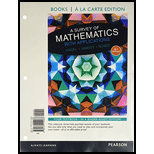
Concept explainers
Weighted Average In Exercises 55 and 56 we use weighted averages. Sometimes when we wish to find an average, we may wish to assign more importance, or weight, to some of the pieces of data. To calculate a weighted average, we use the formula:
Thus, the weighted average is 86.4. Note that Σw does not always have to be 1.00. In Exercises 55 and 56, use the weighted average formula.
55. Course Average Suppose that your final grade for a course is determined by a midterm exam and a final exam. The midterm exam is worth 40% of your grade, and the final exam is worth 60%. If your midterm exam grade is 84 and your final exam grade is 94, calculate your final weighted average.
Want to see the full answer?
Check out a sample textbook solution
Chapter 12 Solutions
Survey of Mathematics with Applications, A, a la Carte edition plus NEW MyLab Math with Pearson eText (10th Edition)
- I've been struggling with this because of how close the numbers are together!! I would really appreciate if someone could help me❤️arrow_forwardWhy charts,graphs,table??? difference between regression and correlation analysis.arrow_forwardMatrix MЄ R4×4, as specified below, is an orthogonal matrix - thus, it fulfills MTM = I. M (ELES),- m2,1. We know also that all the six unknowns mr,c are non-negative with the exception of Your first task is to find the values of all the six unknowns. Think first, which of the mr,c you should find first. Next, consider a vector v = (-6, 0, 0, 8) T. What's the length of v, i.e., |v|? Using M as transformation matrix, map v onto w by w = Mv provide w with its numeric values. What's the length of w, especially when comparing it to the length of v? Finally, consider another vector p = ( 0, 0, 8, 6) T. What's the angle between v (from above) and p? Using M as transformation matrix, map p onto q by q = Mp - provide q with its numeric values. What's the angle between w and q, especially when comparing it to the angle between v and p?arrow_forward
- (c) Find the harmonic function on the annular region Q = {1 < r < 2} satisfying the boundary conditions given by U (1, 0) = 1, U(2, 0) 1+15 sin (20). =arrow_forwardQuestion 3 (a) Find the principal part of the PDE AU + UÃ + U₁ + x + y = 0 and determine whether it's hyperbolic, elliptic or parabolic. (b) Prove that if U(r, 0) solves the Laplace equation in R², then so is V(r, 0) = U (², −0). (c) Find the harmonic function on the annular region = {1 < r < 2} satisfying the boundary conditions given by U(1, 0) = 1, U(2, 0) = 1 + 15 sin(20). [5] [7] [8]arrow_forwardNo chatgpt pls will upvote Already got wrong chatgpt answer Plz .arrow_forward
- 7. (a) (i) Express y=-x²-7x-15 in the form y = −(x+p)²+q. (ii) Hence, sketch the graph of y=-x²-7x-15. (b) (i) Express y = x² - 3x + 4 in the form y = (x − p)²+q. (ii) Hence, sketch the graph of y = x² - 3x + 4. 28 CHAPTER 1arrow_forward- (c) Suppose V is a solution to the PDE V₁ – V× = 0 and W is a solution to the PDE W₁+2Wx = 0. (i) Prove that both V and W are solutions to the following 2nd order PDE Utt Utx2Uxx = 0. (ii) Find the general solutions to the 2nd order PDE (1) from part c(i). (1)arrow_forwardSolve the following inhomogeneous wave equation with initial data. Utt-Uxx = 2, x = R U(x, 0) = 0 Ut(x, 0): = COS Xarrow_forward
- Could you please solve this question on a note book. please dont use AI because this is the third time i upload it and they send an AI answer. If you cant solve handwritten dont use the question send it back. Thank you.arrow_forward(a) Write down the general solutions for the wave equation Utt - Uxx = 0. (b) Solve the following Goursat problem Utt-Uxx = 0, x = R Ux-t=0 = 4x2 Ux+t=0 = 0 (c) Describe the domain of influence and domain of dependence for wave equations. (d) Solve the following inhomogeneous wave equation with initial data. Utt - Uxx = 2, x ЄR U(x, 0) = 0 Ut(x, 0) = COS Xarrow_forwardQuestion 3 (a) Find the principal part of the PDE AU + Ux +U₁ + x + y = 0 and determine whether it's hyperbolic, elliptic or parabolic. (b) Prove that if U (r, 0) solves the Laplace equation in R2, then so is V (r, 0) = U (², −0). (c) Find the harmonic function on the annular region 2 = {1 < r < 2} satisfying the boundary conditions given by U(1, 0) = 1, U(2, 0) = 1 + 15 sin(20).arrow_forward
 Trigonometry (MindTap Course List)TrigonometryISBN:9781337278461Author:Ron LarsonPublisher:Cengage Learning
Trigonometry (MindTap Course List)TrigonometryISBN:9781337278461Author:Ron LarsonPublisher:Cengage Learning
 Holt Mcdougal Larson Pre-algebra: Student Edition...AlgebraISBN:9780547587776Author:HOLT MCDOUGALPublisher:HOLT MCDOUGAL
Holt Mcdougal Larson Pre-algebra: Student Edition...AlgebraISBN:9780547587776Author:HOLT MCDOUGALPublisher:HOLT MCDOUGAL Glencoe Algebra 1, Student Edition, 9780079039897...AlgebraISBN:9780079039897Author:CarterPublisher:McGraw Hill
Glencoe Algebra 1, Student Edition, 9780079039897...AlgebraISBN:9780079039897Author:CarterPublisher:McGraw Hill Functions and Change: A Modeling Approach to Coll...AlgebraISBN:9781337111348Author:Bruce Crauder, Benny Evans, Alan NoellPublisher:Cengage Learning
Functions and Change: A Modeling Approach to Coll...AlgebraISBN:9781337111348Author:Bruce Crauder, Benny Evans, Alan NoellPublisher:Cengage Learning Algebra: Structure And Method, Book 1AlgebraISBN:9780395977224Author:Richard G. Brown, Mary P. Dolciani, Robert H. Sorgenfrey, William L. ColePublisher:McDougal Littell
Algebra: Structure And Method, Book 1AlgebraISBN:9780395977224Author:Richard G. Brown, Mary P. Dolciani, Robert H. Sorgenfrey, William L. ColePublisher:McDougal Littell





